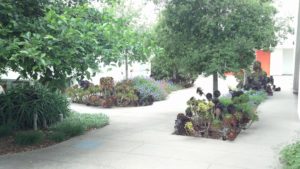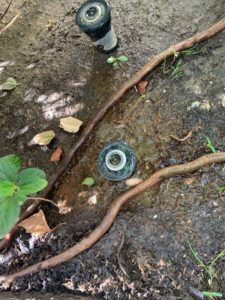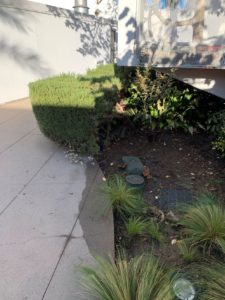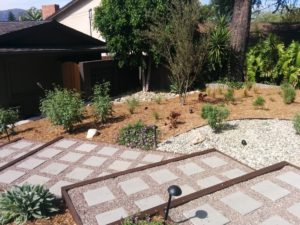Irrigation systems are complex. They are designed to control moving water, one of the most transformative forces on our planet (although household and business irrigation systems are usually simpler than say, a hydroelectric dam). Regardless, even the simplest system will eventually need maintenance repairs. Creative Concepts Landscape is here to help.
This week we will look at a few irrigation errors commonly found within cultivated landscapes, and what can be done to repair them.
Much of Southern California has an arid climate. We are blessed with beautiful pine mountains, rolling chaparral hills, and coastal sage biomes brushing against the beach, but plentiful rain? No, we don’t have that.

Our naturally arid chaparral
For decades many Southern Californians have engineered our landscapes to fit an aesthetic more appropriate in wetter climates. Those lush long belts of green lawn need water, and a considerable amount of it. This means an extensive irrigation system to make up for our lack of rainwater.
Properly working, efficient irrigation systems will become all the more important as landscape irrigation becomes more restrictive in Southern California.

Large lawns need large amounts of water to stay healthy. This picture is from the Griffith Observatory.
We are seeing more homeowners, and business owners, turn to low water landscapes (often called drought tolerant landscapes) to help save money and reduce the use of one of our most precious natural resources – water. These landscapes mimic a more natural ecology for our region with plants that need minimal irrigation, once they are established.
However, unless you have the time and inclination to hand water your landscape regularly, an automated irrigation system is necessary to keep your plants healthy and beautiful.

Low water use landscapes are well suited for our Southern California climate, however low water use does not mean no water use.
Like any system with moving parts, irrigation systems need maintenance. A well designed and well-built system absolutely makes a difference, however, eventually maintenance and repairs will be needed.
As the weather heats up in summer, and the landscape begins to require more irrigation, issues with irrigation systems often become more frequent. Let’s take a look at a few common landscape frustrations with irrigation systems and what services Creative Concepts Landscape can provide for you.
Irrigation Controller Adjustments

The face of an irrigation controller – where adjustments to the watering schedule are made
Irrigation controllers are the brains of the irrigation system. At their most basic, controllers have a built-in clock that tells which valves to turn on (open) at what time and for how long.

Inside the brains of the operation – the wires are like nerves sending electrical pulses, telling what to move and when
At Creative Concepts Landscape, when we check a controller for a new property, we often find the watering schedule is not properly adjusted leaving the landscape with too much, or too little, water.
There is a science to how much water areas of the landscape need according to the season, the types of plants present, the type of irrigation present (sprinklers, drip, etc.), and specific location conditions such as the amount of sun or shade received.
Knowing how to properly adjust a controller comes with experience and observation. There are ways to test soil moisture with sensors, however the installation and repair of these systems can be expensive. These sensors are very rare outside of orchards and other agricultural commercial enterprises.
At Creative Concepts Landscape, our technicians will test your controller and make all needed adjustments to the watering schedule based on our considerable experience working with landscapes and irrigation systems.
Contact us today to set up an irrigation check for your property.
Malfunctioning Irrigation Valves

A brass irrigation valve
Irrigation valves are the gates at which water is held. When they open, water is released downstream through the lateral lines of your system and out into the soil via sprinklers or drip lines.
All irrigation systems have valves. Some are only opened manually, but more commonly in our modern era, they are connected to an automated electronic system (the irrigation controller).
Because irrigation valves have moving parts within them, they will eventually wear down and need repair or replacement.
Two of the most common issues with irrigation vales is that they are either stuck open, or stuck closed.
- When a valve is stuck open, water is continually passing through and going out to the lateral lines. If your sprinklers or drip lines won’t turn off (or are continually leaking), you might have a valve that is not closing properly.
- Valves might become stuck open for a number of reasons, from a small rock being stuck inside, a malfunctioning solenoid (a magnetic devise that opens or closes the valve), physical damage to the valve body, or simply an old valve that has been worn down over the years.
- When a valve is stuck closed, water does not pass through to your landscape. This might be the issue when your sprinklers or drip lines are not emitting water when they are supposed to.
- A valve that is stuck closed is often indicative of an issue with the solenoid. As mentioned before, a solenoid is a magnetic devise within the valve body that will open or close the valve depending on whether it receives an electronic pulse or not. Another common reason valves become stuck closed is that there is an issue with the wiring running from the irrigation controller to the valve.

Sprinklers that continually leak water might indicate a valve that is not closing properly
In order to determine if a valve is malfunctioning, for any reason, one needs to check through the system and trouble shoot piece by piece. At Creative Concepts Landscape, our irrigation technicians will check your entire system, starting with the irrigation controller, and working our way down the electrical lines, through the valves, and out to the sprinklers or drip emitters. A systematic approach is the best way to determined where the problem lies.
Contact us today to set up an irrigation check for your property.
Too Much Water or Too Little Water – that is the question
Plants that are dying are often thought to be receiving too little water. Sometimes this is true, sometimes it’s not. Plants that continually receive too much water will die the same as if they are not receiving enough.
It is important to check the soil around the plant. Is it bone dry down to six inches or so? That could be an issue. Is the soil sopping wet even though the irrigation has not come on recently? That could also be an issue.

Continually sopping wet soil will eventually damage and even kill the surrounding plants
Sitting water on the soil is usually a sign of too much water. Most plants do not like to sit in water, they want well-draining soil. However, there are many nuances here. Different plants at different locations want differing amounts of water at different times of the year.
Creative Concepts Landscape has been working with plants and irrigation systems for around 30 years. Our experienced technicians will determine if your landscape is receiving too much or too little water, and why.
Irrigation systems are complex. They operate at the confluence of electronic/mechanical/hydro engineering and botany. Well designed and built irrigation systems need periodic maintenance and repairs to continue efficient operation, keeping your landscape healthy and beautiful.

A beautiful low water use landscape to welcome you home
Creative Concepts Landscape will check your irrigation and make the needed repairs and refurbishments, so your system stays efficient in its water use. Contact us today to learn more about our services.
By Daniel Williams
Client Liaison for Creative Concepts Landscape Management
Resources:
Ewing – Irrigation and landscape materials store with multiple locations around Southern California and the United States


Very cool article!
Thank you!
Great blog topic!
Thank you! Yes, it is an important one for Southern California landscapes.
Thank you for the information. I’m interested in having your team come take a look at my irrigation system.
Great, thank you, Gralion. Please email us at [email protected] and we will set that up.
Excellent article. I definitely appreciate this site. Keep writing!
Thank you, Larry! Will do, every Wednesday we upload a new post.